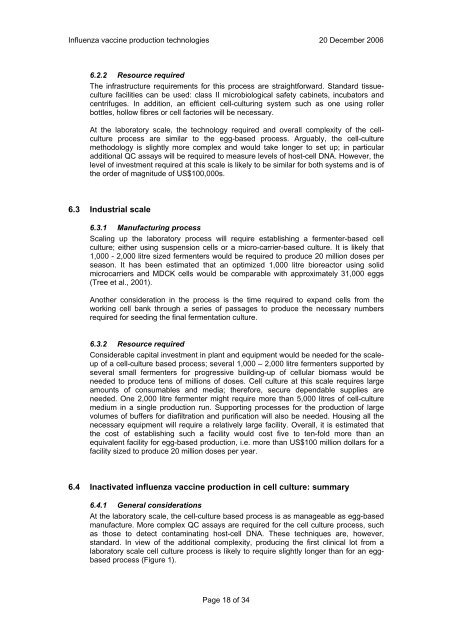A review of production technologies for ... - World Health Organization
A review of production technologies for ... - World Health Organization
A review of production technologies for ... - World Health Organization
You also want an ePaper? Increase the reach of your titles
YUMPU automatically turns print PDFs into web optimized ePapers that Google loves.
Influenza vaccine <strong>production</strong> <strong>technologies</strong> 20 December 2006<br />
6.2.2 Resource required<br />
The infrastructure requirements <strong>for</strong> this process are straight<strong>for</strong>ward. Standard tissueculture<br />
facilities can be used: class II microbiological safety cabinets, incubators and<br />
centrifuges. In addition, an efficient cell-culturing system such as one using roller<br />
bottles, hollow fibres or cell factories will be necessary.<br />
At the laboratory scale, the technology required and overall complexity <strong>of</strong> the cellculture<br />
process are similar to the egg-based process. Arguably, the cell-culture<br />
methodology is slightly more complex and would take longer to set up; in particular<br />
additional QC assays will be required to measure levels <strong>of</strong> host-cell DNA. However, the<br />
level <strong>of</strong> investment required at this scale is likely to be similar <strong>for</strong> both systems and is <strong>of</strong><br />
the order <strong>of</strong> magnitude <strong>of</strong> US$100,000s.<br />
6.3 Industrial scale<br />
6.3.1 Manufacturing process<br />
Scaling up the laboratory process will require establishing a fermenter-based cell<br />
culture; either using suspension cells or a micro-carrier-based culture. It is likely that<br />
1,000 - 2,000 litre sized fermenters would be required to produce 20 million doses per<br />
season. It has been estimated that an optimized 1,000 litre bioreactor using solid<br />
microcarriers and MDCK cells would be comparable with approximately 31,000 eggs<br />
(Tree et al., 2001).<br />
Another consideration in the process is the time required to expand cells from the<br />
working cell bank through a series <strong>of</strong> passages to produce the necessary numbers<br />
required <strong>for</strong> seeding the final fermentation culture.<br />
6.3.2 Resource required<br />
Considerable capital investment in plant and equipment would be needed <strong>for</strong> the scaleup<br />
<strong>of</strong> a cell-culture based process; several 1,000 – 2,000 litre fermenters supported by<br />
several small fermenters <strong>for</strong> progressive building-up <strong>of</strong> cellular biomass would be<br />
needed to produce tens <strong>of</strong> millions <strong>of</strong> doses. Cell culture at this scale requires large<br />
amounts <strong>of</strong> consumables and media; there<strong>for</strong>e, secure dependable supplies are<br />
needed. One 2,000 litre fermenter might require more than 5,000 litres <strong>of</strong> cell-culture<br />
medium in a single <strong>production</strong> run. Supporting processes <strong>for</strong> the <strong>production</strong> <strong>of</strong> large<br />
volumes <strong>of</strong> buffers <strong>for</strong> diafiltration and purification will also be needed. Housing all the<br />
necessary equipment will require a relatively large facility. Overall, it is estimated that<br />
the cost <strong>of</strong> establishing such a facility would cost five to ten-fold more than an<br />
equivalent facility <strong>for</strong> egg-based <strong>production</strong>, i.e. more than US$100 million dollars <strong>for</strong> a<br />
facility sized to produce 20 million doses per year.<br />
6.4 Inactivated influenza vaccine <strong>production</strong> in cell culture: summary<br />
6.4.1 General considerations<br />
At the laboratory scale, the cell-culture based process is as manageable as egg-based<br />
manufacture. More complex QC assays are required <strong>for</strong> the cell culture process, such<br />
as those to detect contaminating host-cell DNA. These techniques are, however,<br />
standard. In view <strong>of</strong> the additional complexity, producing the first clinical lot from a<br />
laboratory scale cell culture process is likely to require slightly longer than <strong>for</strong> an eggbased<br />
process (Figure 1).<br />
Page 18 <strong>of</strong> 34

















